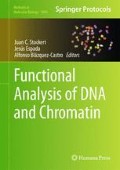Abstract
Most methods currently available for the analysis of chromatin in vivo rely on a priori knowledge of putative chromatin components or their posttranslational modification state. The isolation of defined native chromosomal regions provides an attractive alternative to obtain a largely unbiased molecular description of chromatin. Here, we describe a strategy combining site-specific recombination at the chromosome with an efficient tandem affinity purification protocol to isolate a single-copy gene locus from the yeast Saccharomyces cerevisiae. The method allows robust enrichment of a targeted chromatin domain, making it amenable to compositional, structural, and biochemical analyses. This technique appears to be suitable to obtain a detailed description of chromatin composition and specific posttranslational histone modification state at virtually any genomic locus in yeast.
Access this chapter
Tax calculation will be finalised at checkout
Purchases are for personal use only
References
Higashinakagawa T, Wahn H, Reeder RH (1977) Isolation of ribosomal gene chromatin. Dev Biol 55:375–386
Zhang XY, Hörz W (1982) Analysis of highly purified satellite DNA containing chromatin from the mouse. Nucleic Acids Res 10: 1481–1494
Workman JL, Langmore JP (1985) Nucleoprotein hybridization: a method for isolating specific genes as high molecular weight chromatin. Biochemistry 24:7486–7497
Boffa LC, Carpaneto EM, Allfrey VG (1995) Isolation of active genes containing CAG repeats by DNA strand invasion by a peptide nucleic acid. Proc Natl Acad Sci U S A 92: 1901–1905
Griesenbeck J, Boeger H, Strattan JS et al (2003) Affinity purification of specific chromatin segments from chromosomal loci in yeast. Mol Cell Biol 23:9275–9282
Simpson RT, Ducker CE, Diller JD et al (2004) Purification of native, defined chromatin segments. Methods Enzymol 375:158–170
Ghirlando R, Felsenfeld G (2008) Hydrodynamic studies on defined heterochromatin fragments support a 30-nm fiber having six nucleosomes per turn. J Mol Biol 376:1417–1425
Déjardin J, Kingston RE (2009) Purification of proteins associated with specific genomic loci. Cell 136:175–186
Unnikrishnan A, Gafken PR, Tsukiyama T (2010) Dynamic changes in histone acetylation regulate origins of DNA replication. Nat Struct Mol Biol 17:430–437
Antão JM, Mason JM, Déjardin J et al (2012) Protein landscape at Drosophila melanogaster telomere-associated sequence repeats. Mol Cell Biol 32:2170–2182
Byrum SD, Raman A, Taverna SD et al (2012) ChAP-MS: a method for identification of proteins and histone posttranslational modifications at a single genomic locus. Cell Rep 2: 198–205
Unnikrishnan A, Akiyoshi B, Biggins S et al (2012) An efficient purification system for native minichromosome from Saccharomyces cerevisiae. Methods Mol Biol 833:115–123
Rigaut G, Shevchenko A, Rutz B et al (1999) A generic protein purification method for protein complex characterization and proteome exploration. Nat Biotechnol 17: 1030–1032
Puig O, Caspary F, Rigaut G et al (2001) The tandem affinity purification (TAP) method: a general procedure of protein complex purification. Methods 24:218–229
Brown CR, Mao C, Falkovskaia E et al (2013) Linking stochastic fluctuations in chromatin structure and gene expression, PLoS biology 11, e1001621
Hamperl S, Brown C, Perez-Fernandez J et al (in revision) Compositional and structural analysis of selected chromosomal domains from S. cerevisiae
Oeffinger M, Wei KE, Rogers R et al (2007) Comprehensive analysis of diverse ribonucleoprotein complexes. Nat Methods 4:951–956
Laemmli UK (1970) Cleavage of structural proteins during the assembly of the head of bacteriophage T4. Nature 227:680–685
Towbin H, Staehelin T, Gordon J (1979) Electrophoretic transfer of proteins from polyacrylamide gels to nitrocellulose sheets: procedure and some applications. Proc Natl Acad Sci U S A 76:4350–4354
Mumberg D, Müller R, Funk M (1995) Yeast vectors for the controlled expression of heterologous proteins in different genetic backgrounds. Gene 156:119–122
Flick JS, Johnston M (1990) Two systems of glucose repression of the GAL1 promoter in Saccharomyces cerevisiae. Mol Cell Biol 10:4757–4769
Johnston M (1987) A model fungal gene regulatory mechanism: the GAL genes of Saccharomyces cerevisiae. Microbiol Rev 51: 458–476
Acknowledgements
This work was supported by a grant to H.T, P.M, and J.G. in the context of the SFB960 DFG research center. We thank all the members of the Institute of Biochemistry III for their constant support.
Author information
Authors and Affiliations
Editor information
Editors and Affiliations
Rights and permissions
Copyright information
© 2014 Springer Science+Business Media, New York
About this protocol
Cite this protocol
Hamperl, S. et al. (2014). Purification of Specific Chromatin Domains from Single-Copy Gene Loci in Saccharomyces cerevisiae . In: Stockert, J., Espada, J., Blázquez-Castro, A. (eds) Functional Analysis of DNA and Chromatin. Methods in Molecular Biology, vol 1094. Humana Press, Totowa, NJ. https://doi.org/10.1007/978-1-62703-706-8_26
Download citation
DOI: https://doi.org/10.1007/978-1-62703-706-8_26
Published:
Publisher Name: Humana Press, Totowa, NJ
Print ISBN: 978-1-62703-705-1
Online ISBN: 978-1-62703-706-8
eBook Packages: Springer Protocols

